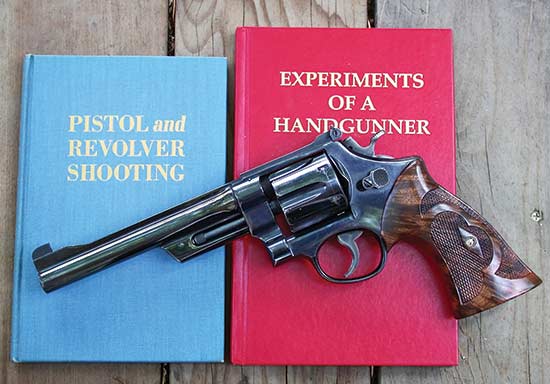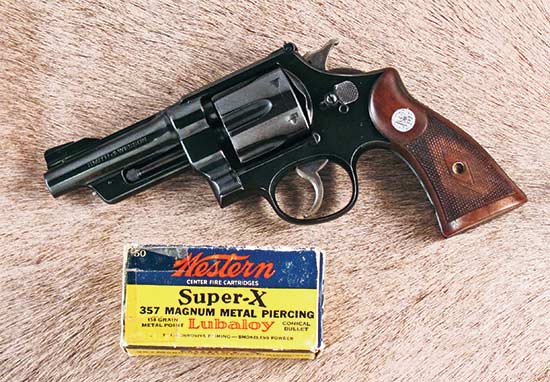Past Masters of the Double-Action Sixgun
Part 4: Walter Roper And Phil Sharpe
Walter Roper’s books are still worth reading; Keith Brown replicates the Roper stocks. This S&W .357
Magnum from the 1930s is stocked with Roper grips.
There is no doubt we are living in the age of the semi-automatic pistol. However, this was not always the case and during the last century, especially from the 1920s to the 1970s, the double-action sixgun was definitely the King.
There were many men who raised the use of the double action to both a high art and science. These men need to be remembered for their contributions and with that in mind we go back in history when six shots were the norm and all that was needed. All of these men are now gone. As a kid never did I ever imagine I would actually know many of these sixgunners.
Walter Roper
There was a time in my life, during the first half of the 1960s, when I mostly lived on dreams. No, not daydreams, as the biggest problem was just staying awake as I sat in class after working the night shift in a factory. I had no choice if I was to go to school as I had three babies and a wonderful wife to support. It was not an easy time, I was always tired, however, I also knew I was very specially blessed to be able to work a full-time job and attend school full time and Dot could stay home with the kids. We had money to live on, however there definitely was no expendable income for guns and/or equipment and even if there was there certainly was no time for using them.
When I wasn’t working, sleeping, attending classes, or doing homework I often dreamed of the sixguns I would have in the future. Those dreams were inspired by such books as Elmer Keith’s Sixguns, Ed McGivern’s Fast and Fancy Revolver Shooting, and Walter Roper’s Pistol and Revolver Shooting. I have copies of all of these now, however in those days I could only afford the first one and checked the other two out of the library on a regular basis. These books not only are a great source of information about shooting sixguns, most of those sixguns were customized in one way or the other, and especially so with custom stocks.
On page 179 of Keith’s Sixguns we have a picture of four of Elmer’s Smith & Wesson double-action sixguns, a 6-1/2-inch .357 Magnum, a 6-1/2-inch .44 Special Triple-Lock Target, a 4-inch .44 Special 1950 Target, and a 6-inch K-22 Masterpiece. The last line in the caption says, “Kearsarge custom grips on top two guns.” There is a much better picture of Kearsarge grips on page 455 of McGivern’s book and he also mentions Kearsarge and Walter Roper on page 287. In Roper’s book, of course, we have more pictures of stocks by Walter Roper who also designed the “Target” grip for the Smith & Wesson .357 Magnum which was carried over to later .44 Specials and the .44 Magnum. I can’t imagine shooting Magnum N-Frames without Roper or Roper-style grips!
The Gripmakers
By the time I could even think of buying more sixguns let alone custom grips both Roper and Kearsarge were gone. Anyone finding one of the old S&W sixguns equipped with carved examples of either grip has really found something special. What is really interesting about both grips is the fact Roper grips were not made by Roper and Kearsarge was not a man but a mountain. Walter Roper was a designer not a woodworker and Kearsarge Woodcraft Co. put out grips made by one Charles Wendell, Jr. In either case the work was magnificent.
Thanks to an article, “The Gripping Story of Walter F. Roper” by Kevin Williams which appeared in a Smith & Wesson Collectors Journal, we know a lot more about Walter Roper. Williams tells us Roper was born in 1881 and in 1921 while shooting a .45 ACP S&W Model 1917 he realized something needed to be done about the grips and his experiments began. His first pair or grips were relatively crude, however he met a French clockmaker and master craftsman by the name of Mathias Gagne who translated Roper’s designs into wood. The fact he was a Frenchman accounts for much of the checkering looking like the fleur-de-lis pattern. Roper did not care much for checkering however we can be thankful he allowed it to be carried out in his grips.
Roper as designer had several principles he wanted to be followed in producing custom grips. These included the middle finger supporting most of the weight of the gun, the stocks covered the frame completely, the heel of the hand was placed to the left of the pistol centerline, a palm swell filled in the hollow of the hand, and a thumb rest was added for precise placement of the hand for each shot. Of course, for fast double action shooting a thumb rest was not necessary nor even desired.
The Kearsarge
When it comes to Kearsarge custom grips we do know that Wendell pre-dated Roper as he started making grips in the 1920s establishing Kearsarge Woodcrafters in the 1930s in New Hampshire in sight of the Kearsarge Mountain. Wendell said of his grips, “Shaped to individual specifications and carved in a pattern which facilitates an unchanging shooting position. The carved pattern, a unique aid to higher scores, provides a perfect non-slip surface without a filing action on the hand, even with the heaviest caliber handgun. Hand carved from genuine selected Circassian walnut, monogram on one side.”
Both Walter Roper and Charles Wendell starting making grips designed for target shooters. The coming of the Magnum double-action sixguns made the filler behind the triggerguard just as important for anyone who shot a heavily loaded, double-action sixgun chambered in the Magnums or used with heavily loaded .45 Colts or .44 Specials. There was a time S&W grips closely followed the Roper design, however that disappeared with the demise of the “diamond” stocks or shortly thereafter.
Phil Sharpe
When the .357 Magnum came out in 1935, it was loaded with a Sharpe-designed bullet as he had been in on the ground floor of the development of both the .357 Magnum revolver from S&W and the cartridge. Phil’s bullet design had a shorter nose than Keith’s .38 bullet and would work in a .357 Magnum cylinder using the crimping groove. It still lives today and I do believe that RCBS’s 38-150KT is a very close approximation of Sharpe’s design.
Sharpe was a dedicated handloader and spent many years on the staff of American Rifleman. His book, Complete Guide to Handloading, can still be found on book tables at gun shows and still makes fascinating reading more than 80 years after the first copy was published in 1937. As a writer with all the modern conveniences of progressive presses, electronic scales, and sophisticated chronographs at my disposal, I stare in awe at the work put into Sharpe’s book on handloading. Sharpe did not just cover a few favorite calibers, he covered everything available at the time.
In this day of thousands upon thousands of reloaders loading everything from .357 Magnum to the .500 S&W, it is quite fascinating to see what Sharpe had to say about reloading the .357 Magnum. Remember, Sharpe worked very closely with Col. Wesson in developing the .357 Magnum including the longer brass as compared to the .38 Special. Both of them did much field work with the new cartridge. Sharpe says of loading the .357 Magnum back in the 1930s, “Developing the full charge load is a major problem. Essentially the factories use a special non-canister grade of Hercules 2400, not available to handloaders. The obvious step then is standard 2400. Charges must be weighed carefully and if this powder is used, it must not be varied between the recommended charges.
“The powder will not work well at low pressures and is inclined to be erratic if the load is increased even slightly beyond the recommended limit. The writer does not recommend the handloading of full charges by the average person and desires to make this clearly known. You are loading far more power than has ever been crammed into a revolver cartridge and in doing so you load at your own risk. The Hercules Powder Company and Smith & Wesson refuse to recommend the reloading of this particular number because of this. It can be done by the careful man, however. But if care was ever needed in the reloading of a revolver cartridge it most certainly applies to this particular number. The handloader will do much better to use these cases and load standard .38 Special charges.”
Sharpe’s load for the .357 Magnum with his 146-grain hollowpoint was 16.0 grains of 2400, much hotter than any recommendations today, for 1,655 feet per second. This was a maximum load as one might well expect. With Unique and the same bullet the maximum charge was 8.5 grains for 1,520 fps. Sharpe worked with 100 different handloads, with 10 different powders leading up to the .357 Magnum. His Sharpe bullet was based on Elmer Keith’s .38 Special design, but made lighter and shorter with the .357 Magnum in mind. It was engineered to have approximately 80 percent of the bearing surface of Keith’s 358429 .38 Special bullet and also to cast closer to sizing diameter. The .357 project apparently caused hard feelings between Sharpe and Keith at least on Keith’s part as one seems to get this impression in reading Elmer’s writings.
Keith Brown Grips
3586 Crab Orchard Ave.
Beavercreek, Ohio 45430
(937) 426-4147
http://www.keithbrowngrips.com/






